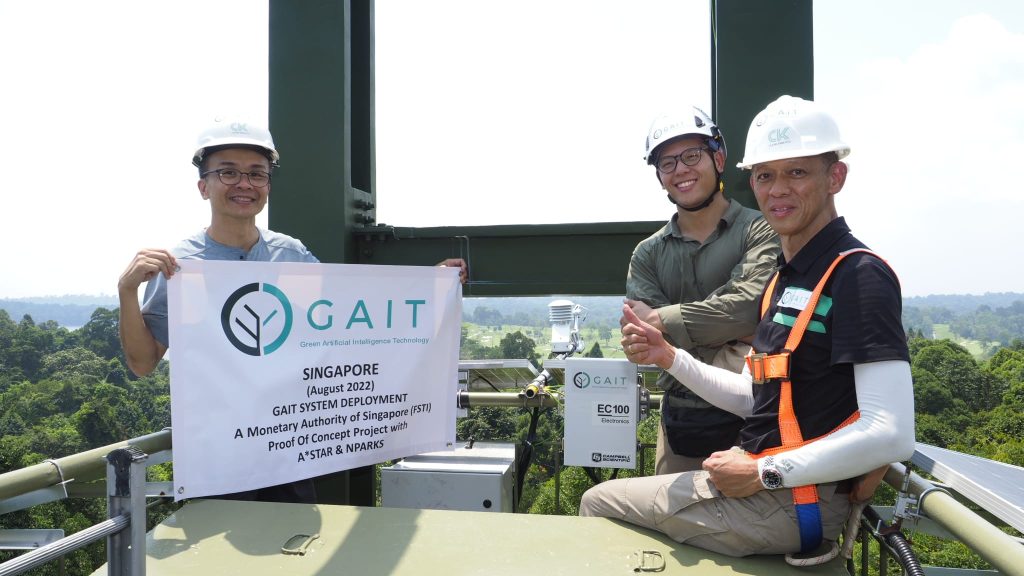
GAIT (Green Artificial Intelligence Technology) Global, a Singapore-based climate group specialising in carbon projects, Nature-based Solutions (NbS), and green technologies, has been awarded the Monetary Authority of Singapore (MAS) Financial Sector Technology and Innovation (FSTI) Proof of Concept (POC).
The FSTI POC grant provides funding support for experimentation, development, and dissemination of nascent innovative technologies in the financial services sector. GAIT utilised the grant to execute a POC project to validate GAIT’s Measuring, Reporting and Verifying (MRV) solution as an integrative system to quantify carbon flux and carbon-related metrics.
GAIT, in collaboration with Agency for Science, Technology & Research (A*STAR) and The National Parks Board (NParks) selected the MacRitchie Reservoir as the ideal site for the POC project.
GAIT said in a statement that it successfully installed an open path flux sensor, the ground-truthing component of The GAIT System, on top of the MacRitchie TreeTop Walk, validating The GAIT System against industry standards and ‘best practise’ for quantifying carbon flux and sequestration.
The GAIT Engine demonstrating the Monitoring, Reporting, and Verifying solution
This POC carbon project successfully demonstrated how the GAIT System (an integrated approach that combines flux data to ground truth, spatial data using machine learning) is compatible with measuring carbon project metrics, as a digital Measuring, Reporting, and Verifying (MRV) solution.
NbS have the potential to sequester large amounts of carbon from the atmosphere, offering a net-zero pathway and greater climate resilience. However, many of these NbS projects are facing challenges due to outdated MRV techniques that do not account for the complex and dynamic nature of ecosystems and in relation, the actual amount of carbon sequestrated.
The success of carbon markets will be determined by the advancements of digital infrastructure used for MRV emission-reducing activities, ensuring emission-related data is scalable, secure, and accurate, said GAIT.
As such, the project successfully validated The GAIT System as a method to measure carbon flux for carbon projects, enabling GAIT to market the GAIT System as an MRV tool for established pipeline projects that aim to produce carbon credits.
As an emerging sector, NbS is key to achieving a circular economy. The market for NbS is currently estimated at US$2 billion per year, and could unlock US$4.3 trillion of annual economic value and 232 million jobs in Asia Pacific by 2030.
Meanwhile, NbS is projected to provide some of the most important emission reduction opportunities, they are also some of the most difficult to measure. Today, MRV is often carried out through manual implementation, requiring in-person inventories and physical assessment of the project.
“The recent focus on electric vehicles, solar energy, and other green technologies are proof that the world is shifting towards cleaner energy sources. As more consumers realise that excessive dependence on fossil fuels is not sustainable, the demand for green energy products will inevitably fuel the expansion of green technology,” shares Saurav Bansal, CEO of GAIT Global.
“Blue carbon projects are crucial in generating high-quality carbon removals from the rejuvenation of coastal and marine ecosystems. While the carbon capture and sequestration market size is expected to grow to US$7 billion by 2028, blue carbon measurement is still at its experimental stage with no widely accepted and reliable MRV tools to effectively measure blue carbon. Our partnership with Temasek Foundation aims to fill that market gap, and further advance carbon removal technologies,” Bansal added.
Established in 2022, GAIT now has a team of more than 35 members globally, with more than seven million hectares of carbon projects in the pipeline across blue, green and brown carbon abatement pools. GAIT is one of the global forerunners, spearheading a new blue carbon methodology with Temasek Foundation.














